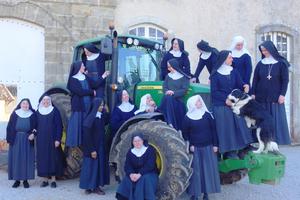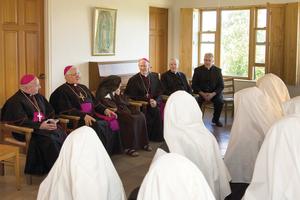Gregorian Chant and Wine Is a Fruitful Pairing for These French Nuns
Famous for the beauty of their Gregorian chants, the Benedictine nuns of the Abbey Notre-Dame de Fidélité of Jouques in the Provence region have been developing wines of excellence since 1967.

In recent years, the nuns of the Abbey of Notre-Dame de Fidélité in Jouques, a few kilometers north of Aix-en-Provence, have gained international recognition through their participation in the Neumz project, a smartphone app offering streaming of the entire Gregorian chant repertoire of the Novus Ordo liturgy.
But it’s also for the outstanding quality of their local produce, particularly their Provence wines, that this dynamic Benedictine community has made a name for itself in France, with major media outlets recently showing an interest in monastic initiatives, especially when they promote new forms of female entrepreneurship.
In this respect, the activities of Jouques Abbey, located in the idyllic setting of the Provence region and whose hospitality welcomes many visitors in search of peace and recollection every year, ticks all the boxes.
A Path to Excellence
Since settling in Jouques in 1967, the community, which today numbers some 45 nuns, has lived by the Benedictine rule of prayer and work, their activity being mainly focused on the running of their vast 150-acre estate overlooking the Durance Valley.

They ensure their livelihood through producing many local delicacies, which they sell directly from their abbey store or on platforms dedicated to monastic products.
The vast fields of fruit and olive trees, lavender and einkorn that surround the abbey enable them to commercialize oils, hydrolats, jams, honey, cookies and other delicatessen items prized by the public.
As for their vineyards, they extend over 20 acres of land, the vastness of which leads Sister Armelle, the abbey’s cellarer, to joke that the community’s only enclosure is the cliffside that borders their estate.

“When the first nuns arrived here in 1967, there were abandoned vineyards and apricot groves all over the land, and as they were looking for ways to earn a living, they rehabilitated them, and initially limited themselves to producing wines which they stored in the abbey cellars for local sales,” Sister Armelle said in an interview with the Register.
Indeed, it was not until 2005 that the first marketable bottles were developed, with the original design we know today, inspired by the drawings of Mother Geneviève Gallois, a famous artist from the same community who died in 1962. The first vintages yielded two red wines. The first one, Louange, is an emblematic cuvée blending Syrah with an old Grenache vine planted in 1950, which enhances its quality and sublimates the brightness of its color, giving it notes of ripe fruit and spices. “While the young vines ensure quantity, the old ones produce very good grapes, as do the wines themselves, which improve with age,” Sister Armelle explained.

The second wine, Fidelis, is made from Merlot vines planted in 2000 on the estate’s highest plateau and called Notre Dame de France. It has red fruit aromas and notes of blueberry and black cherry.

“As our expertise grew year after year, we realized that we couldn’t decently produce Provence wines without offering rosé, which is always closely associated with the region in the minds of wine lovers,” she continued. Thus, in 2017, the community purposefully planted 6 acres of vines for rosé, whose first vintage, a blend of Grenache, Syrah and Caladoc, saw daylight in 2020 under the name Exsulta. This elegant wine, with its pale pink color and citrus notes, has already won rave reviews.

This reputation gives the community hope for future international development, particularly in the U.S., where customers are particularly fond of Provence rosés.

“We strive to guarantee consistent quality for our products by making sure that our grapes are as beautiful as possible, but as our products are not industrial, there may be slight variations due to the climate,” said the Benedictine cellarer, precising that the community takes care of the entire agricultural work, from caring for the vines and soils to harvesting the grapes. The wine-making process is then carried out in the cellar of a neighboring village, a step that the Jouques nuns follow closely, right up to the final tasting before bottling.
Allegory of the Liturgy
In their quest for excellence, the nuns spare no effort. While they hand-pick the grapes for the red wine, the rosé grapes require mechanical harvesting, which begins in the middle of the night. “For rosé to be of the highest quality,” explains Sister Armelle, “the time between cutting the grapes and pressing them has to be as short as possible. That’s why we usually activate the harvester around 3 a.m., so that the grapes can be delivered to the cellar at dawn.”
This leaves the nuns a couple of hours to get on with the task, before joining the other nuns in the chapel at 5 a.m. sharp for the first of seven offices of the day, the chants of which are streamed on the Neumz app.

It is in fact to the liturgy that the abbey’s three wines appeal, as a kind of allegory of the communion between a God-given gift and the work of man.
While Louange refers to the Divine Office or Liturgy of the Hours, and Fidelis echoes the name of their Abbey, Exsulta (inspired by Zechariah 9:9 “Rejoice greatly, O daughter of Zion, behold your King is coming to you”) is meant to reflect the joy of working the land and vines in such a spectacular setting as Provençal France.
“This land has been given to us, as if it were only waiting for our community to come, and we have made it bear fruit as best we could,” said the Benedictine nun, pointing to Christ’s recurring use of the image of vine and wine to illustrate his love and presence in the world.

In her eyes, winegrowing is indeed a privileged meeting place with God. “The liturgy is the ultimate expression of a gift from God to which men respond with their work, and this communion of the two dimensions is what the Lord has desired from the beginning and for all eternity,” she concluded.
The fruit of this providential alliance, which brings delight to connoisseurs, also comes to garnish the table of the abbey’s nuns on Sundays and feast days, as a divine reward for their perseverance in the quest for the good and the beautiful.
This sweet image is like a nod to the memory of the famous Franco-British writer Hilaire Belloc. “Wherever the Catholic sun doth shine, / There’s always laughter and good red wine,” he wrote. “At least I’ve always found it so. / Benedicamus Domino!”
PURCHASE PRODUCTS
- Keywords:
- religious life
- catholicism in france
- wine
- Provence
















